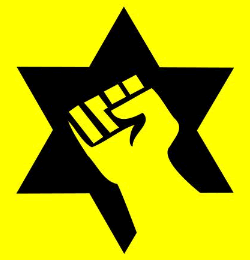 |
| Jewish Defense League |
This militant organization soon became involved in an unlikely, even bizarre, political alliance and was also subjected to both U.S. and local government surveillance. The 1990 assassination of the founder, Meir Kahane, later raised serious questions about an Arab conspiracy, fueled by much new evidence discovered in the wake of the terrorist attacks of 11 September 2001.
Paradoxically, some members of the Jewish Defense League—who professed profound concern for the physical safety and welfare of their coreligionists—were implicated in the 26 January 1972 murder of a Jewish secretary, Iris Kones. This tragic killing took place during the firebombing of the New York office of Sol Hurok, who promoted cultural exchanges with the Soviet Union.
Later, however, some charges were dropped against the JDL members because of illegal police procedures and other problems for the prosecution. Almost all mainstream Jewish organizations considered the JDL a violent, extremist group and regularly denounced its leader.
Founded in the spring of 1968 by the charismatic rabbi Meir Kahane and a group of politically conservative New York City Jews, the JDL and its activities were regularly featured in the New York media and, occasionally, the national press.
Indeed, one member boasted that the U.S. ambassador to the United Nations, George H.W. Bush, complained to Israeli Prime Minister Golda Meir that JDL activities were endangering détente with the Soviet Union.
Although the JDL was a right-wing organization, both its methods and often violent rhetoric seemed to mirror radical leftist groups of the 1960s. Leon Wieseltier, the New Republic literary editor and a JDL member for a brief time, once boasted to his parents that Eldridge Cleaver was making him a better Jew.
Although many journalists and academics have written numerous articles describing and analyzing the political activities and philosophy of the JDL, relatively little attention has been paid to an unusual political alliance that developed during the early years of the organization.
After Meir Kahane was freed on bail in Brooklyn Federal Court on 3 May 1971 from an indictment of conspiracy to transport weapons across state lines, Joseph A. Colombo, Sr., a major Mafia figure, appeared in a joint news conference with the JDL leader and announced an alliance with him. Colombo declared that the rabbi was “fighting for his people in Russia and we’re fighting for our [Italian] people here ... if they [the JDL] need our support, we will give it”.
A year earlier, Colombo and some of his mob associates had formed the New York–based Italian American Civil Rights League—grist for comedians and editorial cartoonists—whose mission was to fight anti-Italian prejudice, especially the depiction of all Italians as gangsters. Barry Slotnick, counsel to the newly established organization, was also the attorney for Kahane, and reportedly helped intro- duce these two controversial figures to each other.
A New York Times editorial (15 May 1971) expressed puzzlement about this bizarre organizational alliance: the Italian American Civil Rights League seemed an unlikely group to place as one of its top priorities concern over the mistreatment of Soviet Jews; similarly, JDL members would not likely highlight as a major issue in its political agenda the removal of the names “Mafia” and “Cosa Nostra” from the television program The FBI.
Nevertheless, some analysts suggested that Kahane and Colombo forged this alliance to mobilize jointly their respective supporters against their alleged systematic harassment by the U.S. Department of Justice.
The real reason for the alliance might never be known. On 29 June 1971, Joseph Colombo, Sr., was shot three times in the head and neck at an Italian American Unity Day Rally held at Columbus Circle and attended by an estimated 100,000 supporters.
Colombo was in a coma for seven years and died on 22 May 1978. His assailant—who was immediately shot and killed by Colombo’s bodyguards—was Jerome A. Johnson, an African American who allegedly had mob ties in Harlem.
Almost two decades later, Rabbi Meir Kahane also suffered a violent death. On 5 November 1990, an Egyptian janitor named El Sayyid Nosair assassinated the JDL leader before a group of JDL supporters at the Marriott Hotel in midtown Manhattan.
Subsequent investigations found intriguing connections between Nosair and many terrorists involved in either the first or second attacks on the World Trade Center (WTC) and also other worldwide terrorist activities perpetrated by Al-Qaeda.
Immediately captured after the Kahane shooting, Nosair was later found to be a follower of the exiled Egyptian cleric Sheik Omar Abdel-Rahman, then based in Jersey City, New Jersey. He was reportedly the spiritual leader who inspired the first World Trade Center bombing on 26 February 1993.
Furthermore, police discovered that Mohammed Salameh and Mahmoud Abouhalima—who were key players in the WTC bombing—were staying in Nosair’s house also in Jersey City, located near Abdel-Rahman’s mosque. Nosair’s cousin, Ibrahim el-Gabrowny obtained a $20,000 contribution from Osama bin Laden for Nosair’s legal defense.
Wadi El-Hage, the key Al-Qaeda operative involved in the 1998 bombings of the U.S. embassies in Kenya and Tanzania, visited Nosair in his U.S. prison, several years before he went to East Africa. El Sayyid Nosair, who was acquitted of the Kahane murder in a state trial in 1991, was convicted in 1995 on a federal charge of murder in aid of racketeering, and was sentenced to life in prison.